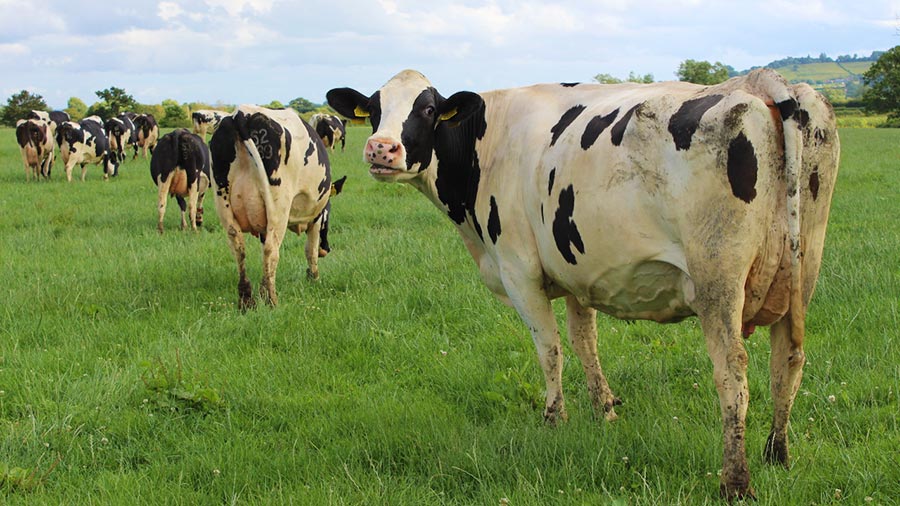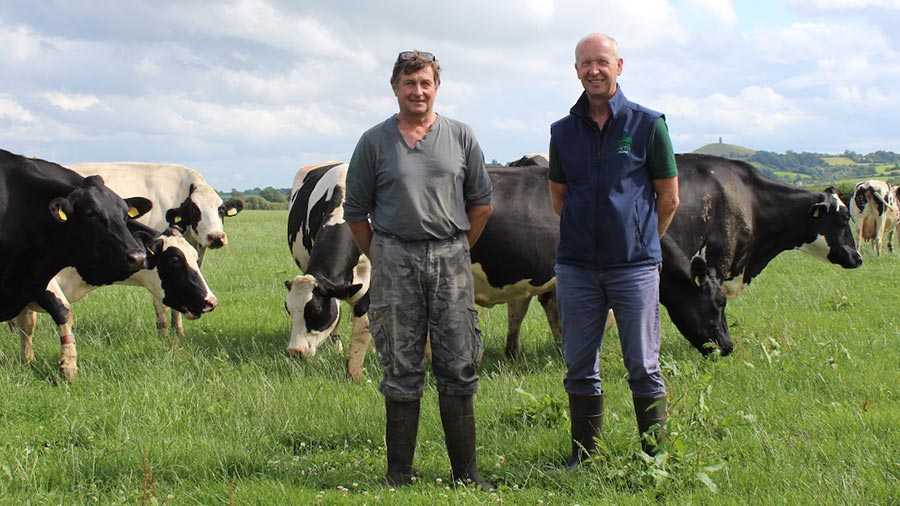How a dairy farm pilot tackled conception and culling rates
 The dairy herd at New Manor Farm © Aly Balsom
The dairy herd at New Manor Farm © Aly Balsom Giving repeat breeders a holding injection after service has improved conception rates and reduced forced culls at New Manor Farm in Somerset.
Like many dairy farmers, Martin Hawkins was frustrated with the number of “good” cows that were failing to get pregnant after three or more services and had to be culled to maintain efficiency.
“It’s when you lose the good ones that it’s a problem, as you’ve got less choice over which cows to get rid of,” Martin explains. That means retaining a higher number of less efficient animals.
See also: High-yielding herds top efficiency stakes – but beware of low fertility
According to Kingshay’s Dairy Costings Focus Report 2023, fertility issues account for 24.9% of herd culls, with repeat breeders making up 6.3%.
Having to serve cows multiple times also represents a significant drain on funds, with Kingshay putting the cost of an extended calving interval at £5.89 a cow a day over 365 days.
With the cost of infertility clear, and the number of repeat breeders at about 15% in his 850-cow herd, Martin was keen to address the issue.
The farm team was already practising a high standard of herd fertility management (see “Herd fertility fundamentals at New Manor Farm”), but there were still 15% of cows requiring three or more services and, therefore, at risk of culling.
Farm facts: New Manor Farm, Wells, Somerset
- 850 Holsteins
- Three-times-a-day milking
- 10,000 litres a cow a year at 4.4% fat and 3.5% protein
- Supplies Saputo
- 162ha farmed on the principal farm plus 405-486ha contract-farmed on various agreements to produce forage for their own use
- Year-round calving
- Youngstock are contract-reared off farm
On-farm trial opportunity
Vet Paddy Gordon of Shepton Vets says even if good fertility management is in place, repeat breeders will always be a problem, partly because some cows are naturally less fertile.
He suggested Martin take part in an on-farm pilot using the gonadotropin-releasing hormone (GnRH) off licence after service, as a means of maintaining a pregnancy.
Paddy had read a Spanish study from the University of Lleida, where the use of the GnRH dephereline at two-and-a-half times the conventional dose, five to seven days after service, had resulted in a pregnancy rate of 39.1%. This compared with 28.6% in non-treated repeat breeders.
The dosage, and the time it was given, set this study apart from previous work, and he was keen to see if such a strategy had a role to play on his clients’ farms.
GnRH is naturally produced by the pituitary gland and stimulates the release of luteinising hormone (LH), which promotes the production of progesterone.
High levels of progesterone in early pregnancy are needed for embryo growth and establishment and maternal recognition of pregnancy, says Paddy.

Martin Hawkins and vet Paddy Gordon © Aly Balsom
Improved conception rate
Nineteen cows that had failed to hold were enrolled onto the study (see “Pilot study – cost benefits at New Manor Farm”). Nine out of 19 held. “That’s not only a positive outcome, but we’re also achieving normal conception rates of 45% in those animals,” says Paddy.
Martin adds: “For that group of animals, it’s very high. I was quite surprised to get so many in-calf, and the ones you’d given up on.”
At about £9 for the treatment, he says the cost is “negligible,” particularly as some (or all) of those nine cows would have been culled.
In addition, he believes this should help environmental targets because fewer herd replacements will need to be kept on farm.
Paddy is keen to get more of his clients involved in using this to get cows in-calf at the optimum time.
“We want a calf a cow a year. To achieve that, we need most of our cows to get pregnant between 50 and 150 days after calving. There’s a window of opportunity to get that cow in-calf.
“The economic benefit would be significant, as we’ll retain those cows in the herd and get them in-calf at a reasonable time to maintain production,” he explains, adding that milk production will show a more marked decline after 200 days.
Cows conceiving after 200 days are more likely to be fat at the next calving as a result of relative overfeeding during their extended lactation, he adds.
Careful targeting
Martin says missing that optimum window leads to a “vicious cycle” of cows getting fat and having calving issues and reduced fertility.
However, both stress that using a GnRH holding injection is not the answer to poor management. “If you’ve got other problems in the herd, it won’t fix them,” he says.
Paddy agrees: “It’s about targeting the right cows and addressing the fundamentals of fertility, and not using this as a sticking plaster but maintaining good animals in the herd.
Herd fertility fundamentals at New Manor Farm
- Good heat detection with the help of pedometers
- Top-notch artificial insemination technique
- Quality nutrition
- Healthy cows, vaccinated for bovine viral diarrhoea and infectious bovine rhinotracheitis
- Good cow transition
- Weekly vet visits for pregnancy diagnosis, tackling unseen bullers, addressing health issues and monitoring fertility. The farm aims for 50 pregnancies a month
Pilot study – cost benefits at New Manor Farm
- 19 cows identified as repeat breeders (those empty after three services and at risk of culling, and more than 150 days calved) and that were valuable to the herd – for example, good genetics and yields
- Cows were of varying lactations
- Animals were given 5ml of dephereline – a gonadotropin-releasing hormone (GnRH) – by the farm team five to seven days after service. This is two-and-a-half times the “normal” dose for GnRH
- Cows were pregnancy-diagnosed at a minimum of 30 days after service
- Nine out of 19 held in-calf after treatment (45% conception rate)
- The dephereline cost £170 across the treatment group (about £9 a cow)
- The average benefit of getting a cow pregnant is valued at $278 (£218, A DeVries, 2006). This considers multiple factors such as lactation number, yield, milk price and replacement heifer cost.
- Without treatment, Martin Hawkins’s vet, Paddy Gordon, predicts 28% of the 19 cows (five animals) may have got in-calf without hormonal intervention
- The treatment resulted in four animals becoming pregnant which likely would not have otherwise
- Four cows x £218 benefit = £872 – £170 = £702 estimated net benefit. This value is conservative considering changes in milk price and costs since the 2006 study.
Note: Dephereline requires use off-licence. Speak to your vet for more information.
The numbers
- 2.17 The cost of infertility in p/litre
- £5.89 The daily cost of an extended calving interval over 365 days
- 24.9% Percentage of herd culls for fertility reasons
- 7.2% Infertility culling rate in a herd (taking into account culling rate and herd size)
Source: Kingshay Dairy Costings Focus Report 2023, for the year ending March 2023.
